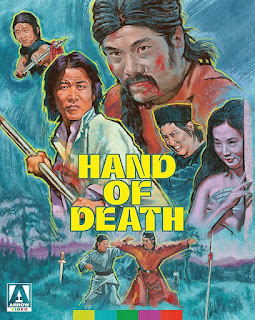Incubus
The films of Ingmar Bergman might be better known for their emotional angst and spiritual turmoil than any supernatural overtones. But there’s an unmistakable horror element imbedded in his visual style. And it’s from this that Incubus, director Leslie Stevens’ nearly-lost 1966 oddity, takes it cue. Filmed entirely in Esperanto, a universal language created at the turn of the 20th century, and starring William Shatner, this folk-horror fable feels like a cross between The Outer Limits and a European art film.
Living a quiet life with his sister, Marc (Shatner) is a modest war hero who becomes a victim of love at first sight with Kia (Allyson Ames), a blonde beauty who tempts him with sexual and moral indiscretions. But Marc is a victim in more ways than one. Kia is actually a succubus, luring greedy and vain men to their death as a sacrifice to the dark lord. However, Marc’s inherent “goodness” provides a new challenge, one which Kia and her brother and sisters in darkness have never faced before.
With a creative team pulled straight from The Outer Limits (director Stevens brought along cinematographer Conrad Hall and composer Dominic Frontiere) there’s an immediate sense of familiarity at play for fans of the show. But Incubus has much more in common with art film imports of the era than anything on network television. The shot compositions, black and white cinematography, obtuse dialogue, even the subtitles practically scream “Made in Sweden.” But there are moments of genuine satanic horror than swing closer to the gothic stylings of Mario Bava than Bergman, scenes that wouldn’t be out of place in the current folk horror movement. Foggy landscapes and decaying buildings set an appropriately eerie mood with all-too physical manifestations of the demonic emerging for the memorable final act.
Criticisms of Shatner’s acting tropes put aside, the actor acquits himself well in a role – and a genre – he really had no business dabbling in. And while the Esperanto dialogue might have been a last-minute novelty that kept the film from wider distribution at the time, now it plays like a miraculous piece of undiscovered cult cinema; one of those films that not only shouldn’t be so successful, but shouldn’t even exist in the first place!
First released on DVD in 2001 and mastered from the only surviving French release print with burned in subtitles, Arrow Video goes the extra mile this time around by providing a Blu-ray limited-edition 4K UHD option. The new 4K restoration is terrific all-around, looking way better than the “release print” description would have you believe. Extras include two archival commentaries with Shatner and company, plus a new track from David J. Schow. Two new video essays focus on the origination of the Esperanto language in general and Hollywood specifically with another archival roundtable interview with the filmmakers. For curiosity’s sake, the film is also presented in an alternate 1.31:1 ratio which reveal more top-bottom visual information…but also includes the burned in French subtitles (which only pop up in the widescreen version intermittently). Packaging includes a reversible sleeve and collector’s booklet not included for review.




Comments
Post a Comment